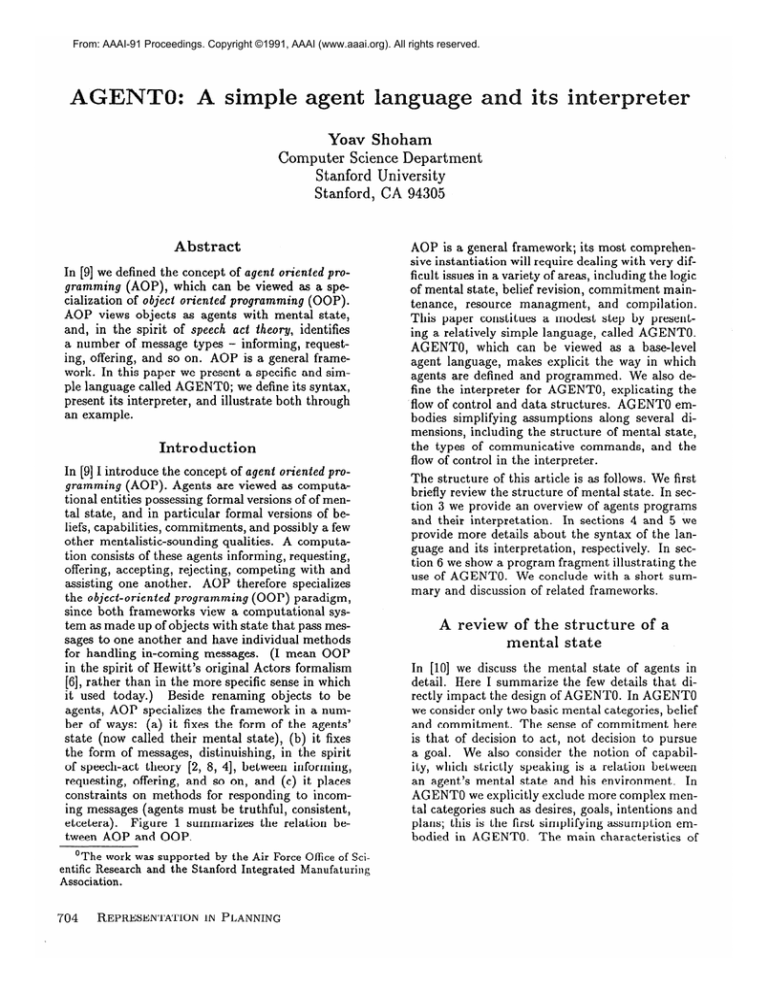
From: AAAI-91 Proceedings. Copyright ©1991, AAAI (www.aaai.org). All rights reserved.
AGENTO:
A simple agent
Yoav Shoham
Computer Science Department
Stanford University
Stanford, CA 94305
Abstract
In [9] we defined the concept of agent oriented programming
(AOP), which can be viewed as a specialization of object oriented programming (OOP).
AOP views objects as agents with mental state,
and, in the spirit of speech act theory, identifies
a number of message types - informing, requesting, offering, and so on. AOP is a general framework. In this paper we present a specific and simple language called AGENTO; we define its syntax,
present its interpreter, and illustrate both through
an example.
Introduction
In [9] I introduce the concept of agent oriented programming (AOP). Agents are viewed as computational entities possessing formal versions of of mental state, and in particular formal versions of beliefs, capabilities, commitments, and possibly a few
other mentalistic-sounding qualities. A computation consists of these agents informing, requesting,
offering, accepting, rejecting, competing with and
assisting one another. AOP therefore specializes
the object-oriented programming (OOP) paradigm,
since both frameworks view a computational system as made up of objects with state that pass messages to one another and have individual methods
for handling in-coming messages. (I mean OOP
in the spirit of Hewitt’s original Actors formalism
[6], rather than in the more specific sense in which
it used today.)
Beside renaming objects to be
agents, AOP specializes the framework in a number of ways: (a) it fixes the form of the agents’
state (now called their mental state), (b) it fixes
the form of messages, distinuishing, in the spirit
of speech-act theory [2, 8, 41, between informing,
requesting, offering, and so on, and (c) it places
constraints on methods for responding to incoming messages (agents must be truthful, consistent,
etcetera).
Figure 1 summarizes the relation between AOP and OOP.
‘The work was supported
by the Air Force Office of Scientific Research
and the Stanford Integrated
Manufaturing
Association.
704
REPRESENTATIONIN PLANNING
AOP is a general framework; its most comprehensive instantiation will require dealing with very difficult issues in a variety of areas, including the logic
of mental state, belief revision, commitment maintenance, resource managment, and compilation.
This paper constitues a modest step by presenting a relatively simple language, called AGENTO.
AGENTO, which can be viewed as a base-level
agent language, makes explicit the way in which
agents are defined and programmed. We also define the interpreter for AGENTO, explicating the
flow of control and data structures. AGENT0 embodies simplifying assumptions along several dimensions, including the structure of mental state,
the types of communicative commands, and the
flow of control in the interpreter.
The structure of this article is as follows. We first
briefly review the structure of mental state. In section 3 we provide an overview of agents programs
and their interpretation. In sections 4 and 5 we
provide more details about the syntax of the language and its interpretation, respectively. In section 6 we show a program fragment illustrating the
use of AGENTO. We conclude with a short summary and discussion of related frameworks.
A review of the structure
mental state
of a
In [lo] we discuss the mental state of agents in
detail. Here I summarize the few details that directly impact the design of AGENTO. In AGENT0
we consider only two basic mental categories, belief
and commitment. The sense of commitment here
is that of decision to act, not decision to pursue
a goal. We also consider the notion of capability, which strictly speaking is a relation between
an agent’s mental state and his environment. In
AGENT0 we explicitly exclude more complex mental categories such as desires, goals, intentions and
plans; this is the first simplifying assumption embodied in AGENTO. The main characteristics of
belief, commitment and capability are as follows:
e One both believes a fact at a given time
For example,
and about a given time.
BzBk”lika(a,b)7
means that at time 3 agent
a believes that at time 10 agent b will believe
that at time 7 a liked b.
e Commitments are defined similarly. However,
unlike B, CMThas an additional index: CMT: b’p
e
e
d
e
o
means that at time t agent a is committed to
agent b about action cp. This inter-agent flavor
of commitment contrasts with past accounts of
the same concept, which viewed it as an intraagent phenomenon.
Actions referred to in the context of capability or
commitment are always actions at specific times.
Belief and commitment have internal restrictions; for example, an agent cannot believe contradictory facts nor be committed to incompatible actions.
Belief and commitment are also mutually constraining. Specifically, an agent is aware of his
commitments (i.e., an agent is committed iff he
believes himself to be), and an agent only commits in good faith (i.e., if an agent commit to a
future fact then he believe the fact will indeed
hold).
An agent is aware of his capabilities (that is,
and agent is capable of an action iff he believes
himself to be), and only commits to actions of
which he is capable.
Beliefs and commitments, as well as their absence, persist by default. On the other hand,
capabilities do not change over time.
It is clear that these properties embody further
simplifying assumptions, which may in the future
be relaxed.
An overview
of AGENT0
The behavior of agents is governed by programs;
each agent is controlled by his own, private proFramework:
Basic unit:
Parameters
defining state
of basic unit:
Process of
computation:
Message types:
OOP
object
unconstrained
AOP
agent
beliefs,
commitments
capabilities, . . .
message passing,
message passing,
response methods
response methods
unconstrained
inform, request,
offer, . . .
honesty,
Constraints on
none
1 consistency, . . .
I
1 methods:
11
Figure 1: OOP versus AOP
gram. Agent programs are in many respects similar to standard programs, containing primitive operations, control structures and input-output instructions. What makes them unique is that the
control structures refer to the mental-state constructs defined previously, and that the IO commands include methods for communicating with
other agents.
An agent program consists of two parts, initialization and commitment
rules. The initialization defines the capabilities of the agent, its initial beliefs
(that is, beliefs at the particular initial time point,
but about any time) and initial commitments. In
other words, this part initializes the mental state
(strictly speaking, capability is a relation between
mental state and the world, but we ignore this detail).
Commitment rules determine how commitments
are added over time. Conditions for making a commitment always refer to the ‘current’ mental state
and the ‘current’ incoming messages. Actions to
which an agent is committed always refer to a particular future point in time.
The order between the commitment rules is completely unimportant, and has nothing to do with
the times of action specified in the various rules.
This stands in a certain contrast with standard
languages. In standard languages there is a simple
mapping between the structure of the program and
the order of execution; typically, a linear sequence
of commands translates to the same execution order. In agent programs, on the other hand, there is
complete decoupling between the order among different commitment rules and the time of execution;
each commitment rule can refer to an action at
any future time. In fact, somewhat paradoxically
agent programs never contain direct instructions
to execute an action. Rather, agents are continually engaged in two types of activity: making commitments about the future, and honoring previous
commitments whose execution time has come (and
which have not been revoked in the meanwhile).
In order to implement this process we will make
assumptions of two kinds:
1. We assume that the platform is capable of
passing message to other agents addressable by
name. The program itself will define the form
and timing of these messages.
2. Central to the operation of the interpreter is the
existence of a clock. The main role of the clock is
to initiate iterations of the two-step loop at regular intervals (every 10 milliseconds, every hour,
etcetera); the length of these intervals, called the
‘time grain,’ is determined by the programmer.
The other role of the clock is to determine which
commitments refer to the current time, and must
SHOHAM
705
therefore be executed.
In AGENT0 we make the very strong assumption
that a single iteration through the loop lasts less
than the time grain; in the future we will relax this
assumption, and correspondingly will complicate
the details of the loop itself. Figure 2 presents a
flowchart of the AGENT0 interpreter.
lncomlng messages
-------SW
lnlttallze belters
def lne rules for
I
I
I
I
data
bases
rx
clock
Figure 2: A flow diagram of AGENT0
The syntax
of AGENT0
We now take a closer look at the syntax of
AGENTO. Full exposition of it is impossible, due
to space limitations; that is provided in [9], including a BNF definition. As was said earlier, the
first part of the program initializes the mental state
of the agent. This is conceptually straightforward
and we skip over it here. The bulk of the program
consists of the commitment rules. The syntax of a
commitment rule is as follows:
COMMIT(msgcond,mntlcond,agent,action)
where msgcond and mntlcond are respectively message and mental conditions (see below), agent is
an agent name, and action is an action statement.
h1ental condition refer to the current mental state
of the agent, and message condition refer to messages received in the current computation cycle.
706
REPRESENTATIONIN PLANNING
We will discuss the syntax further, but the following simple example of a commitment rule may be
helpful at this point:
COMMIT( (?a,REQUEST,?action),
(B,myfriend(?a)),
?a,
?action
)
(Terms preceded by ‘?’ are existentially-quantified
variables.) The intuitive reading of the above rule
is “if you have just received a request from agent a
to take the future action action, and you believe a
to be friendly, then commit to action.” The reader
might have expected additional conditions for entering into the commitment, such as the requested
action being within the agent’s capabilities or the
absence of contradictory prior commitments. However, as is explained in the next section, these conditions are verified automatically by the interpreter
and therefore need not be mentioned explicitly by
the programmer.
We do not give the full syntax of mental conditions
and message conditions; we only mention that, as is
seen in the example, each specify the type (e.g., request, belief) and the content. The example above
contains only atomic conditions; in fact, AGENT0
allows for complex conditions which include the
logical connective of negation and conjunction.
We conclude the abbreviated description of the
syntax with two issues: actions to which an agent
may commit, and variables.
Regarding action
types, we make two orthogonal distinctions: private actions vs. comunicative actions, and conditional actions vs. unconditional ones. Private actions are completely idiosyncratic; examples include rotating a camera platform and retrieving
an item from a data base. Communicative actions,
on the other hand, are uniform among agents.
AGENT0 has only two communicative commands,
INFORM
and REQUEST,and an additional UNREQUEST
type whose effect is to release an agent from an existing commitment. The final unconditional action
type is RERAIN, which has no effect on execution,
but which blocks commitments to a particular action. Conditional actions are simply actions preceded by a mental condition, or a condition referring to the agent’s mental state. The syntax of
the mental condition is identical to its syntax in
commitment rules, but its interpretation is different in the following respect: in commitment rules
mental conditions are evaluated the time at which
the commitment is made, whereas in conditional
actions they are evaluated at the time of action.
The syntax of action statements is summarized in
the following fragment of the BNF definition of the
syntax:
<action>
::=
DO(<time>,<privateaction>)
1
INFORM(<time>,<agent>,<fact>)
1
REQUEST(<time> ,<agent> #<action>)
UNREQUEST(<time>, <agent>, <action:
REFRAIN <action>
1
IF <mntlcond>
THEN <action>
I
4 I
Finally, as is seen in the earlier example, commitment rules may contain variables. Existentiallyquantified variables are denote by the prefix ?.
Universally-quantified variables are denoted by the
prefix ? ! . We do not discuss the roles of the two
types of variable further here, but these will be illustrated in the example shown in section 6.
The interpretation
of AG
programs
We now discuss the details of interpreter, most of
which are quite simple. As in the previous section,
we will only be able to mention some of the more
important features. In section 4 it was explain that
the interpreter operates in cycles, and that each
cycle consisted of two phases:
1. Process the incoming messages, updating the beliefs and commitments.
2. Carry out the commitments for the current time.
The second phase is rather straightforward and will
not be discussed further here. The first phase is
divided into two subphases:
la. Update the beliefs.
lb. Update the commitments.
To discuss these steps we first need to discuss the
representation of beliefs, commitments and capabilities. In AGENT0 they are each represented by
a data base. The belief data base is updated either as a result of being informed or as a result of
taking a private action; here we discuss only the
former update. In AGENT0 agents are completely
gullible: they incorporate any fact of which they
are informed, retracting previous beliefs if necessary. (This is of course an extreme form of belief revision, and future versions will incorporate a more
sophisticated model; see discussion in the final section.) As the result of being informed the agent
not only believes the fact, he also believes that the
informer believes it, that the informer believes that
it (the agent) believes it, and so on. In fact, as the
result of informing, the informer and agent achieve
so-called common bela’ef(the infinite conjunction of
“I believe, ” “I believe that you believe,” etcetera).
The belief data base will therefore include private
beliefs, represented as simple facts, as well as common beliefs, represented by pairs (a,f act) (where
a is the other party).
Items in the data base of capabilities are pairs
(privateaction,mntlcond).
The mental condition part allows one to prevent commitment to incompatible actions, each of which might on its own
be possible. An example of an item in the capability data base is
([!?time,rotate(?!degreel)l
,
NOT (CMT(?!time,rotate(?degree2))
AND B(NOT ?!degreel=?degree2
)))
Items in the data base of commitments are simply pairs (agent ) act ion) (the agent to which the
commitment was made, and the content of the
commitment).
The algorithm for message-induced belief update
consists of repeating the following steps for each
new incoming INFORMmessage from agent a informing of fact:
- Add (a,fact) to the belief data base;
- If fact is inconsistent with the previous beliefs
then modify the old beliefs so as to restore consistency.
This last step is of course potentially complicated;
both the check for consistency and the restoring of
consistency can in general be quite costly, and in
general there will be more than one way to restore
consistency. We will impose sufficient syntactic restrictions on beliefs so as to avoid these problem.
In fact, AGENT0 adopts an extreme restriction,
though one that still admits many interesting applications: it disallows in beliefs any connective
other than negation. As a result both consistency
check and consistency restoration require at most
a linear search of the data base, and much less if a
clever hashing scheme is used. Other less extreme
restrictions are also possible, and will be incorporated in future versions of the language.
Belief change may lead the agent to revoke previous
commitments. One reason that might have been
expected is that the original commitment relied,
among other things, on certain mental conditions
stated in the program. These may have included
belief conditions that have now changed. Nevertheless, while it would be a natural addition in future versions, in AGENT0 the interpreter is not
assigned the responsibility of keeping track of the
motivation behind each commitment; that would
require a reason-maintenance mechanism that we
would rather not incorporate yet. However, while
motivation is not kept track of, capability is. Belief change may remove capabilities, since the capability of each private action depends on mental preconditions. And thus whenever a belief update occurs, the AGENT0 interpreter examines the
current commitments to private action, removes
those whose preconditions in the capability data
SHOHAM
707
base have been violated, and adds a commitment
to immediately inform the agents to whom he was
committed of this development. Exhaustive examinations of all current commitments upon a belief
change can be avoided through intelligent indexing.
It may be surprising to note that the belief update is independent of the program. The update
of commitments, on the other hand, depends on
the program very strongly, and more specifically
on the commitment rules. The algorithm for updating the commitments consists of two steps:
- For all incoming UNREQUEST
messages, remove
the corresponding item from the commitment
data base; if no such item exists then do nothing.
- Check all program commitment-statement; for
each program statement
COMMIT(msgcond,mntlcond,a,action),
if:
- the message conditions msgcond hold of the
new incoming message,
- the mental condition mntlcond holds of the
current mental state,
- the agent is currently capable of the action,
and
- the agent is not committed to REFRAIN
action,
or, if action
is itself of the form
REFRAIN action’,
the agent is not committed
to act ion ).
then commit to a to perform action.
An example
The application we choose is a minor modification
of one due to John McCarthy [7], who uses it to
illustrate his Elephant programming language (see
discussion of Elephant in section 6. The example has to do with the communication between a
passanger and an airline. The relevant activities
of the passanger are querying about flight schedules, making reservations, and collecting boarding
passes at the airport. The relevant activities on the
part of the airline are supplying information about
flight schedules, confirming reservations, and issuing boarding passes. The idea underlying the following program is that confirming a reservation is
in fact a commitment to issue a boarding pass if
the passanger shows up at the appropriate time.
Since some of the low-level definitions are long, it
will be convenient to use abbreviations. We will
therefore assume that AGENT0 supports the use
of macros. We define the following macros:
issue-bp(pass,flightnum,date) =%
IF (B,present(pass))
AND
B( [date/?time],
flight(?from,?to,flightnum))
THEN DO(date/?time-lhr,
physicalissue_bp(pass,flightnum,date))
708
REPRESENTATIONIN PLANNING
Explanation: This no-frills airline issues boarding
passes precisely one hour prior to the flight; there
are no seat assignments.
query-which(t ,asker ,askee ,q) +
REQUEST(t,askee,
IF (B,q) THEN INFORM(t+l,asker,q))
Explanation: queryxhich
requests only a positive
answer; if q contains a universally-quantified variable then query-which requests to be informed of
all instances of the answer to the query q.
query-whether(t,asker,askee,q) 3
REQUEST(t,askee,
IF @,q)
THEN INFORM(t+l,asker,q))
REQUEST(t,askee,
IF (B,NOT q)
THEN INFORM(t+l,asker,NOT
q))
Explanation: query-whether expects either a confirmation or a discomfirmation of a fact. It is usually a bad idea to include in the fact a universallyquantified variable.
We now define the airline agent. To do so we need
to define its initial beliefs, capabilities, and commitment rules.
Of the initial beliefs, the ones relevant here refer to the flight schedule, and the capacity of
each flight.The former are representedin the
form [date/time,fLi.ght(from,to,number)]
(ignoring the fact that in practice airlines have a
more-or-less fixed weekly schedule), and the latter
in the form [date,capacity(flight,number)].
The capability relevant here is that issuing boarding passes. Thus the capability data base contains
a single item:
(physicalissue-bp(?a,?flight,?date),
(B,[?date,capacity(?flight,?N)]) AND
(B,?N>l{a:
((CMT,?a),
physicalissue-bp
(?p ass,?flight ,?date)>}I> >
Explanation: physicalissue-bp
is a private action involving some external events such as printing
a boarding pass and presenting it to the passanger.
The I . . . I denotes cardinality.
Finally, the airline agent has two commitment
rules:
COMMIT(
(?pass,REQUEST,IF (B,?p)
THEN INFORM(?t,?pass,?p)),
(VP),
?pass,
IF (B,?p) THEN INFORM(?t,?pass,?p) )
COMMIT
(
(?pass,REQUEST,issue&p(?pass,?flight,?date)),
true B
?pass,
issue-bp(?pass,?flight,?date)
>
In a more realistic example one would have other
commitment rules, notifying the the passenger
whether his reservation was confirmed, and the reasons for rejecting it in case it was not accepted.
In the current implementation the passenger must
query that separately.
This concludes the definition of the simple airline
agent. In [9] we trace a simulated execution of this
program, starting with several queries and requests
of the passenger and culminating with airline issuing a boarding pass at the airport.
elated and future work
There is a large body of work related to the definition of agents and their mental state. However,
since that is not the focus of the paper, I do not
review that work. To my knowledge there has been
less work on programming languages based on a notion of agenthood. One related effort is McCarthy’s
work on Elephant2000 [7]. This language under
development is also based on speech acts, and the
airline-reservation scenario I have discussed is due
to McCarthy. One issue explored in connection
with Elephant2000 is the distinction between illocutionary and perlocutionary specifications, which
I have not addressed. In contrast to AOP, in Elephant2000 there is currently no explicit representation of state, mental or otherwise. There is other
related work within Distributed AI community (cf.
[l]). Although AOP is, to my knowledge, unique
in its definition of mental state and the resulting
programming language, several researchers have
proposed computational frameworks which have to
do with commitments (e.g., [ll]) and others have
made the connection between object-oriented programming and agenthood (e.g., [5, 31).
We are currently implementing AGENT0 in LISP
for the X-windows environment. A Prolog implementation will start soon. At the same time we are
engaged in writing experimental programs, in areas
as diverse as robotics, traffic control, travel agency
planning and construction site management. As a
result of these experiments the language will undoubtedly be expanded and modified.
In addition to this exploratory activity we are engaged in several research efforts, which include the
following directions:
exploring some of the logical issues that arise in
formalizing the various mental components.
o Relaxing various restrictions embodied
in
AGENTO, such as the restricted form of belief, the naive belief-revision process, and the assumption that the update of mental state lasts
less that some fixed time grain.
e Compiling agent programs to a neutral process
language.
o Designing agent societies, as opposed to individual agents.
eferences
[l] Proceedings of the 10th International Workshop on Distributed Artificial Intelligence.
Technical Report ACT-AI-355-90,
MCC,
Austin, Texas, October 1990.
[2] J. L. Austin. How to Do Things with Words.
Harvard University Press, 1955/1975.
[3] J. Ferber and P. Carle. Actors and agents
as reflective concurrent objects: a Mering IV
perspective. In [l].
[4] P. Grice. Studies in the Ways of Words. Harvard University Press, 1989.
[5] C. Hewitt. Towards open information systems
semantics. In [l].
[S] 6. Hewitt. Viewing control structures as patterns of passing messages. Artificial Intel/igence, 8:323-364,
1977.
[7] J. McCarthy. Elephant 2000: A programming
language based on speech acts, 1990. unpublished manuscript.
[8] J. R. Searle. Speech Acts: An Essay in the
Philosophy of Language.
Cambridge University Press, Cambridge, 1969.
[9] Y. Shoham. Agent Oriented Programming.
Technical Report STAN-CS-90-1335,
Computer Science Department, Stanford University, 1990.
[lo] Y. Shoham, S. R. Thomas, and A. Schwartz.
The mental state of a basic agent, 1990. forthcoming.
The contract net protocol:
[ll] R. G. Smith.
High-level communication and control in a distributed problem solver. IEEE Transactions
on Computers,
C-29( 12): 1104-l 113, December 1980.
e Enriching the notion of mental state by additional components such as intention, as well as
SHOHAM
709








